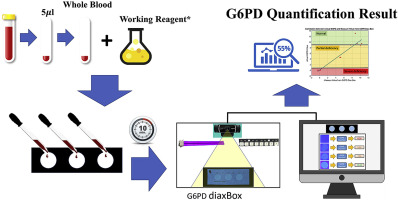Description
Quantitative G6PD (glucose-6-phosphate dehydrogenase) testing measures the level of G6PD enzyme activity in the blood. G6PD is an enzyme that plays a crucial role in protecting red blood cells from damage caused by certain substances, particularly oxidative stress. Deficiency in G6PD enzyme activity can lead to hemolytic anemia, a condition where red blood cells are destroyed faster than they can be produced.
Here’s what you need to know about quantitative G6PD testing:
- Purpose: The test is primarily used to diagnose G6PD deficiency, an inherited condition that affects the function of the G6PD enzyme. G6PD deficiency is most commonly found in males, as it is an X-linked genetic disorder, but females can also be affected, especially if they inherit two defective copies of the gene.
- Testing method: Quantitative G6PD testing measures the activity of the G6PD enzyme in red blood cells. This is typically done using a spectrophotometric assay, which measures the rate at which G6PD catalyzes the conversion of glucose-6-phosphate to 6-phosphogluconate in a blood sample.
- Interpretation of results: Results of quantitative G6PD testing are reported as enzyme activity levels, often measured in units per gram of hemoglobin or as a percentage of normal activity. Individuals with G6PD activity levels below a certain threshold are considered to have G6PD deficiency.
- Clinical significance: G6PD deficiency can cause hemolytic anemia in response to triggers such as certain foods (e.g., fava beans), medications (e.g., certain antibiotics, antimalarials), infections, and oxidative stress. Symptoms of hemolytic anemia may include fatigue, pale skin, jaundice, dark urine, and rapid heart rate.
- Precautions: Prior to testing, it’s essential for healthcare providers to consider factors that may affect G6PD enzyme activity, such as recent transfusions, acute illness, or medications that can induce or exacerbate hemolysis. In some cases, repeat testing may be necessary to confirm the diagnosis.
Quantitative G6PD testing is particularly important for individuals with a family history of G6PD deficiency or those who may be at risk due to ethnicity or exposure to triggers known to cause hemolysis in individuals with G6PD deficiency. Early diagnosis and appropriate management can help prevent complications associated with hemolytic anemia in affected individuals.



Reviews
There are no reviews yet.